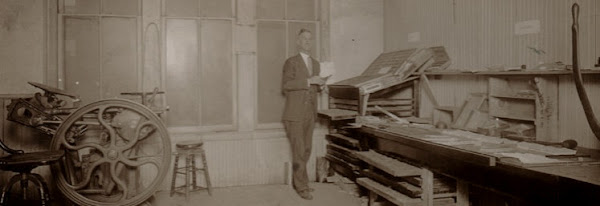
Here is a poor photo from my inadequate camera of the restored proof press. The one I posted previously was taken by the man I got the press from. I've made a new door for it but I'm waiting for a reproduction latch before I mount it. Other than that it's ready to go.
The first step was to completely disassemble everything which was straightforward. I took it to work and sandblasted the castings. I also sanded the wood parts inside and out, removing the dirt, crud, and old paint. Some of the original paint remained on the wood but had been partly covered by the ubiquitous battleship gray. The wood was in good shape though there were a few interesting surprises, one being that while the bottom of the cabinets is pine, the rest is mahogany. As a cabinetmaker I didn't find that painting mahogany was odd as it has excellent rot resisting properties and is often used for exterior, painted millwork instead of cyprus. But I don't see why this characteristic would be desirable in this type of application. The factory may simply have had some in stock or gotten some at a good price. This happens in the shop I work in from time to time.
I wet-sanded the bed after sandblasting to polish it and the original milling marks showed up nicely. It's a bit pitted here and there but not to the point that it will affect its use, especially since the form to be proofed sits in a galley while using the press. I cleaned the cylinder by hand after removing the original felt blanket. I had some thoughts about trying to clean and reuse the blanket but finally decided it was too far gone. Once the cylinder was cleaned I put a new blanket on it, sewing it by hand like the original. You can see the seam in the photo.
The original color was a dark green similar to the Kelly Green I used here. My green is somewhat lighter and is more likely to have been used in the early 1890's if not the 1880's. I was only somewhat concerned with exactly duplicating the color. If money had been no object I would have gotten a color scan. In any case, it's very close and I like it. I brushed the paint on as I do with most of my machine restorations; it gives a thicker coat and is less messy.
I wanted to pull a proof with it but ran out of time. When I do I'll post a photo here. I'm pleased with the way it turned out and I'm happy to finally have the galley proof press I've wanted.
The first step was to completely disassemble everything which was straightforward. I took it to work and sandblasted the castings. I also sanded the wood parts inside and out, removing the dirt, crud, and old paint. Some of the original paint remained on the wood but had been partly covered by the ubiquitous battleship gray. The wood was in good shape though there were a few interesting surprises, one being that while the bottom of the cabinets is pine, the rest is mahogany. As a cabinetmaker I didn't find that painting mahogany was odd as it has excellent rot resisting properties and is often used for exterior, painted millwork instead of cyprus. But I don't see why this characteristic would be desirable in this type of application. The factory may simply have had some in stock or gotten some at a good price. This happens in the shop I work in from time to time.
I wet-sanded the bed after sandblasting to polish it and the original milling marks showed up nicely. It's a bit pitted here and there but not to the point that it will affect its use, especially since the form to be proofed sits in a galley while using the press. I cleaned the cylinder by hand after removing the original felt blanket. I had some thoughts about trying to clean and reuse the blanket but finally decided it was too far gone. Once the cylinder was cleaned I put a new blanket on it, sewing it by hand like the original. You can see the seam in the photo.
The original color was a dark green similar to the Kelly Green I used here. My green is somewhat lighter and is more likely to have been used in the early 1890's if not the 1880's. I was only somewhat concerned with exactly duplicating the color. If money had been no object I would have gotten a color scan. In any case, it's very close and I like it. I brushed the paint on as I do with most of my machine restorations; it gives a thicker coat and is less messy.
I wanted to pull a proof with it but ran out of time. When I do I'll post a photo here. I'm pleased with the way it turned out and I'm happy to finally have the galley proof press I've wanted.



1 comment:
Hi Rich
I've recently purchased a galley press in Australia identical to this! its in slightly better condition than yours was originally (thank goodness, youve got a talent for reconditioning that I dont!) what I was wondering was if there was a particular type of felt you used to replace the felt on the roller, or will any craft felt do?
Thanks - my email is scrapbookorange@bigpond.com if you wouldnt mind emailing me back.
Ellen
Post a Comment